
18
Cheetah 15K.5 SCSI Product Manual, Rev. D
Controlling S.M.A.R.T.
The operating mode of S.M.A.R.T. is controlled by the DEXCPT bit and the PERF bit of the “Informational
Exceptions Control Mode Page” (1Ch). The DEXCPT bit is used to enable or disable the S.M.A.R.T. process.
Setting the DEXCPT bit will disable all S.M.A.R.T. functions. When enabled, S.M.A.R.T. will collect on-line data
as the drive performs normal read/write operations. When the PERF bit is set, the drive is considered to be in
“On-line Mode Only” and will not perform off-line functions.
The process of measuring off-line attributes and saving data can be forced by the Rezero Unit command. Forc-
ing S.M.A.R.T. will reset the timer so that the next scheduled interrupt will be two hours.
The drive can be interrogated by the host to determine the time remaining before the next scheduled measure-
ment and data logging process will occur. This is accomplished by a log sense command to log page 0x3E.
The purpose is to allow the customer to control when S.M.A.R.T. interruptions occur. As described above, forc-
ing S.M.A.R.T by the Rezero Unit command will reset the timer.
Performance impact
S.M.A.R.T. attribute data will be saved to the disc for the purpose of recreating the events that caused a predic-
tive failure. The drive will measure and save parameters once every two hours subject to an idle period on the
SCSI bus. The process of measuring off-line attribute data and saving data to the disc is uninterruptable and
the maximum delay is summarized below::
Reporting control
Reporting is controlled in the Informational Exceptions Control Page (1Ch). Subject to the reporting method,
the firmware will issue a 01-5D00 sense code to the host. The error code is preserved through bus resets and
power cycles.
Determining rate
S.M.A.R.T. monitors the rate at which errors occur and signals a predictive failure if the rate of degraded error
rate increases to an unacceptable level. To determine rate, error events are logged and compared to the num-
ber of total operations for a given attribute. The interval defines the number of operations over which to mea-
sure the rate. The counter that keeps track of the current number of operations is referred to as the Interval
Counter.
S.M.A.R.T. measures error rate, hence for each attribute the occurrence of an error is recorded. A counter
keeps track of the number of errors for the current interval. This counter is referred to as the Failure Counter.
Error rate is simply the number of errors per operation. The algorithm that S.M.A.R.T. uses to record rates of
error is to set thresholds for the number of errors and the interval. If the number of errors exceeds the threshold
before the interval expires, then the error rate is considered to be unacceptable. If the number of errors does
not exceed the threshold before the interval expires, then the error rate is considered to be acceptable. In
either case, the interval and failure counters are reset and the process starts over.
Predictive failures
S.M.A.R.T. signals predictive failures when the drive is performing unacceptably for a period of time. The firm-
ware keeps a running count of the number of times the error rate for each attribute is unacceptable. To accom-
plish this, a counter is incremented whenever the error rate is unacceptable and decremented (not to exceed
Maximum processing delay
On-line only delay
DEXCPT = 0, PERF = 1
Fully-enabled delay
DEXCPT = 0, PERF = 0
S.M.A.R.T. delay times
42 milliseconds
163 milliseconds
Summary of Contents for 15K.5 - Cheetah - Hard Drive
Page 6: ......
Page 8: ...2 Cheetah 15K 5 SCSI Product Manual Rev D...
Page 12: ...6 Cheetah 15K 5 SCSI Product Manual Rev D...
Page 42: ...36 Cheetah 15K 5 SCSI Product Manual Rev D...
Page 92: ......
Page 93: ......
















































